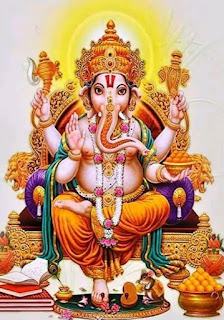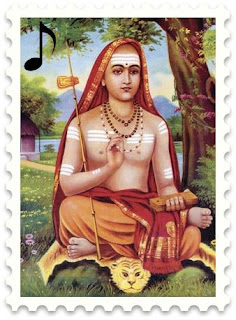This Year, the Ganesh Chaturthi festival is to be celebrated on 26 and 27 August 2025 as the Chaturthi tithi begins at 1:54 pm on 26th and continues till 3 pm on 27th.
The Chaturthi moon will be visible on the evening of the 26th. To avoid any negative effects of seeing the moon on this tithi, we should place the Ganesha idol, perform the worship, and listen to Ganesha's story before leaving home.
The story of Ganesh Chaturthi is an important part of the festival. It is believed that no one should see the moon without reading or hearing the story of Ganesha and Krishna's ShamantakamaNi episode. Otherwise, they will suffer from unnecessary blame and indignity due to Goddess Parvati's curse on the Moon.
So, we should tell the story of Ganesha attaining his title as "Lord of GaNas", why Parvati curses the Moon, and the after-effects of that curse. Lord Krishna was kind enough to turn this curse ineffective for those who read, tell, or remember this story on this day and put some akshata on their heads after performing the Ganesh Puja and hearing the story.
I am sharing this story in a simple format for everyone's benefit.
The Story of Ganesha, Krishna, and Shamantakamani
The entire story of the Ganesh Chauth celebration highlights several key points that emphasize the importance of observing this ritual.
These include the birth of Ganesha, his appointment as Lord of Ganesh and Obstacles, the Curse on the Moon, the story of Sri Krishna being affected by the curse, and his solution to relax the powers and effects of the curse. I am describing all these incidents with appropriate headings in the following paragraphs.
The Story of Gajasura & Ganesha's Birth
According to an incident from the Shiv Purana, the story goes that Lord Shiva granted a boon to a demon Gajaasura (an ardent devotee of Shiva) to reside in his belly and protect him from enemies. When Parvati could not find her consort, Shiva, she approached Brahma, Vishnu, and others for help. Lord Vishnu crafts a plan to save him, and all of them reach Gajasura's city. They reach Gajasura's court in disguised forms with musical instruments, decorating the divine Nandi as a bull. The bull dances to their musical performance. Gajasura was pleased and asked them to tell their wish as he wanted to award them. Vishnu asked for Shiva's release after revealing their identities. Gajasura couldn't retreat from his word. So, he allowed Nandi to break open his belly for the release of Shiva on the condition that his head would be provided a worthy status of reverence and kept with Lord Shiva.
Hearing about the news of Lord Shiva's release, Parvati gets joyous and decides to have a bath to get herself ready to welcome him. Before going to bathe, she made the figure of a child with the sandalwood paste that she used to apply to her skin while bathing, breathed life into it, and kept the child as a guard at the doors to not allow anybody while bathing.
When Lord Shiva enters, the boy stops him as he does not know him. Shiva gets enraged, beheads the child, and enters. Knowing this, Parvati weeps for the child. Realizing his mistake, Shiva orders his ganas (or troops) to bring the head of Gajasura (whom he had given a boon before Lord Vishnu ordered Nandi to break open his womb for Shiva's release), and joins the head to the body of the child and makes him alive. From that time, Ganesha came to be known as Gajaanan.
Ganesha Becomes Lord of GaNas & Protector From Obstacles
Parvati gets happy and celebrates the occasion, inviting all angels, sages, etc. The Devatas and Rishis request Lord Shiva for a Protector who can safeguard them from Obstacles during their daily activities and rituals.
Lord Shiva chooses Ganesha as the head of the ganas and appoints him as the Protector from Obstacles as he wins the test of bathing in all the rivers of the world and returns first to his parents before his brother Kumaraswamy (with the help of the Narayana mantra bestowed to him by Lord Shiva because of his humbleness and respect to his parents).
The Curse on the Moon
All the angels and the troops celebrate the occasion by offering various kinds of food and fruits to Ganesha. After eating all those offerings, Ganesha returns to his parents and tries to bend down to pay obeisance to them, seeking blessings. But due to his heavy belly (after eating so much food offered by so many beings), he experiences much difficulty in bowing to them.
Witnessing Ganesha's inability to bend his body, the Moon on the head of Lord Shiva breaks into laughter. Immediately, the stomach of Ganesha breaks out, and he falls down unconscious on the floor with all the food scattered out from his belly. Goddess Parvati gets very angry at this with the Moon and curses him, saying that whoever sees him will get a bad name and ill luck thereafter.
Lord Shiva comforts Parvati and brings Ganesha into life using his powers on the advice of Brahma, Vishnu, and others.
Parvati Relaxed the Curse, But Krishna Became a Victim of the Curse
Later, all people, including sages, approached Parvati and asked her to lift her curse on the Moon, as it is impossible to go through life without seeing the moon. Parvati understood their concern and said that she couldn’t completely undo her curse, but she could ease it. The curse would only apply for one day each year, specifically on Ganesh Chaturthi, and on that day, no one should look at the moon. They all agreed and followed her instructions.
Later, after many years, Lord Krishna happened to see the moon reflected in the milk while he was churning the cows on Ganesh Chaturthi. He was worried about this sight and foresaw that he might also be affected by that curse.
A king named Satrajit once pleased the Sun God through his prayers and received a golden jewel called Shamantakamani. It has magical powers to produce 160 tulas of gold daily (one Tula equals 10 grams) for anyone who keeps the jewel with them. After acquiring it, the king visited Lord Krishna and shared the secret of his possession. Krishna asked him to give it to him, but the king refused and returned home.
After that incident, one day Satrajit's brother happens to wear it and goes hunting in the forests, where he gets killed by a lion. The lion swallowed the jewel, thinking it to be meat. Jambavantha, an immortal vanara in the shape of a bear of the Ramayana period, was roaming around at that time. He sees the dazzling jewel in the belly of the lion and kills it. Jambavantha ties the jewel to the cradle of his small daughter to play with it.
When Satrajit finds his brother missing, he accuses Lord Krishna of killing his brother and stealing the jewel. Krishna realizes that he got this false accusation because of the curse on the Moon, as he witnessed the Moon in the milk.
Krishna's Fight With Jambavantha & Relaxation of the Curse
So Krishna immediately sets out to find Satrajit's brother to prove his innocence and discovers a dead body and a lion's carcass some distance away. Following the footprints, he reaches Jambavantha's cave, where a jewel shines brightly like the sun, tied to the cradle of Jambavantha's daughter. When he snatches the jewel, the child cries, and Jambavantha arrives, fiercely fighting Sri Krishna. The battle lasts continuously for 21 days, with neither side giving in. Jambavantha then realizes that he is fighting Sri Rama from the Ramayana era, whom he had foolishly challenged when seeking a reward for his service. Acknowledging his mistake, he bows to Sri Krishna, asks for forgiveness, and returns the jewel along with his daughter as a gift.
Sri Krishna returns the jewel to King Satrajit after telling him everything that happened. The king feels ashamed of his actions, seeks Krishna's forgiveness, and gives the jewel to him as a form of repentance. He also requests Krishna to marry his daughter Satyabhama. Lord Krishna accepts Satyabhama but returns the jewel to keep with Satrajit.
When all the angels, sages, and human beings come to know of these incidents, they reach Sri Krishna and ask for his help in seeking a remedy for saving themselves, also from the curse of Goddess Parvati. Then Sri Krishna feels pity for them and tells them to remember this story and read it or hear it from others on this day of Ganesh Chaturthi each year after offering prayers to Ganesha and taking the prasadam, and then they will not get any bad name on seeing the moon on that day.
So from that day onwards, everybody began performing Ganesh Pooja and hearing the story of Lord Ganesha and the Shamanthakamani story of Sri Krishna each year on this auspicious day.











.jpg)


